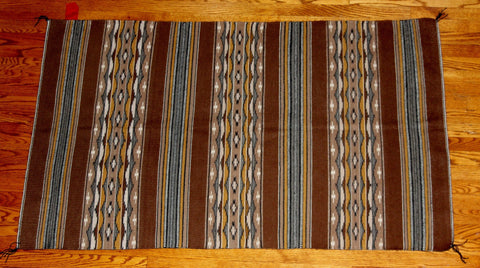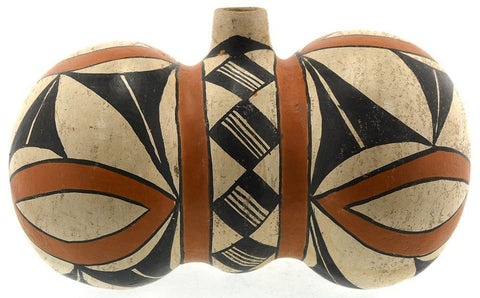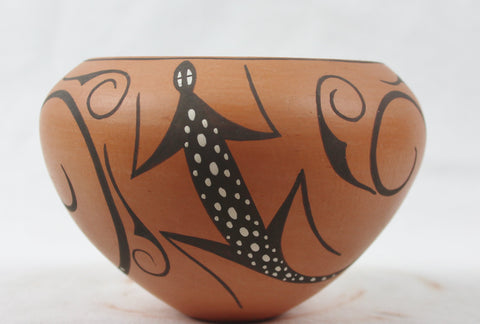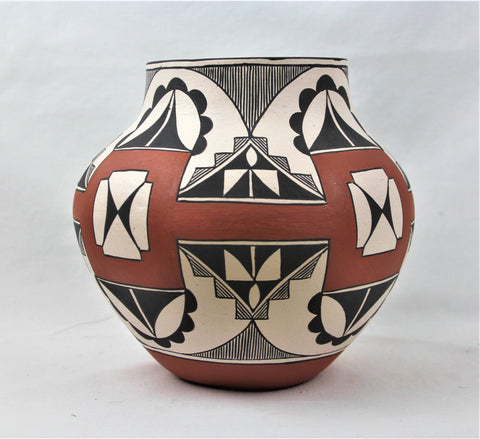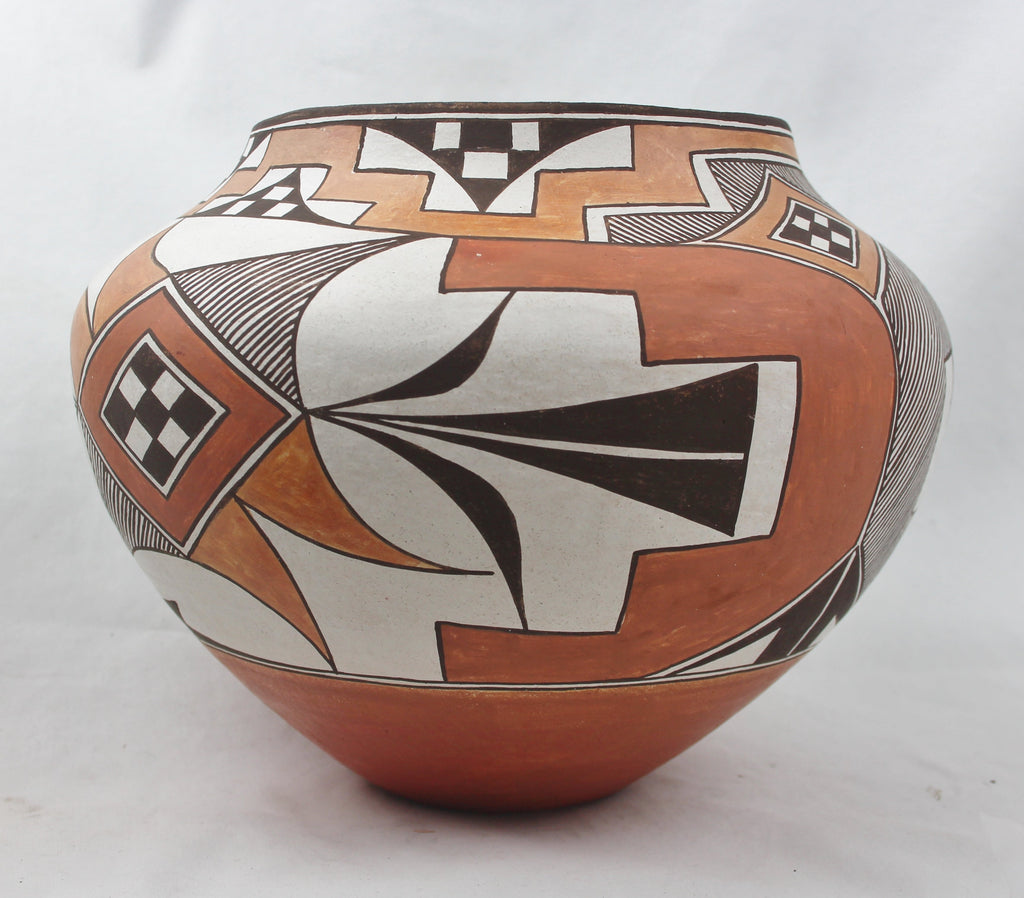
Native American, Vintage Acoma Poly Chrome Pottery Olla, Ca. 1975, By L. Concho, #1464 Sold
$ 2,625.00
Native American, Vintage Acoma Poly Chrome Pottery Olla, Ca. 1975, By L. Concho, #1464 -Sold
Description: #1464 Native American, Vintage Acoma Poly Chrome Pottery Olla, Ca. 1975, By L. Concho, Lolita Concho was born circa 1910 at Acoma Pueblo. She spent her life at the pueblo making pottery for collectors and museums. She was an outstanding potter and one of the few who could make large jars. She was commissioned to make large jars like the ones in R. C. Gorman's lithographs “Water Carrier” and “Acoma” in the early 1980's. The results were breathtaking. She was a prize-winning potter who found time to teach the techniques of pottery making to her daughter-in-law, Dorothy Torivio.
Dimension: 9" x 9.5"
Condition: In overall excellent condition. No breaks, cracks, or chips. Surfaces with only a couple of dings and abrasions. No apparent restoration.
Provenance: Professor Julia R. Weertman Collection. Julia Randall Weertman (February 10, 1926 – July 31, 2018) was an American materials scientist who taught at Northwestern University as the Walter P. Murphy Professor of Materials Science and Engineering.
She was the first female student of the College of Science and Engineering at the Carnegie Institute of Technology, where she earned her baccalaureate and graduate degrees.[1] Weertman met her husband Johannes at Carnegie, and both later joined the Northwestern University faculty.[2] In 1986, Julia Weertman was awarded a Guggenheim Fellowship.[3] She became the first woman in the United States to lead a materials science department when she was appointed chair of Northwestern's Department of Materials Science and Engineering the next year.[1] Weertman was granted membership into the National Academy of Engineering in 1988, "for exceptional research on failure mechanisms in high-temperature alloys."[4] She was also a fellow of the American Academy of Arts and Sciences.[1] Weertman died, aged 92, on July 31, 2018.[1] (Source: Wikepedia)
---------
“Pueblo pottery is made using a coiled technique that came into northern Arizona and New Mexico from the south, some 1500 years ago. In the four-corners region of the US, nineteen pueblos and villages have historically produced pottery. Although each of these pueblos use similar traditional methods of coiling, shaping, finishing and firing, the pottery from each is distinctive.
Various clays gathered from each pueblo’s local sources produce pottery colors that range from buff to earthy yellows, oranges, and reds, as well as black. Fired pots are sometimes left plain and other times decorated—most frequently with paint and occasionally with appliqué. Painted designs vary from pueblo to pueblo, yet share an ancient iconography based on abstract representations of clouds, rain, feathers, birds, plants, animals and other natural world features.
Tempering materials and paints, also from natural sources, contribute further to the distinctiveness of each pueblo’s pottery. Some paints are derived from plants, others from minerals. Before firing, potters in some pueblos apply a light colored slip to their pottery, which creates a bright background for painted designs or simply a lighter color plain ware vessel. Designs are painted on before firing, traditionally with a brush fashioned from yucca fiber.
Different combinations of paint color, clay color, and slips are characteristic of different pueblos. Among them are black on cream, black on buff, black on red, dark brown and dark red on white (as found in Zuni pottery), matte red on red, and poly chrome—a number of natural colors on one vessel (most typically associated with Hopi). Pueblo potters also produce un decorated polished black ware, black on black ware, and carved red and carved black wares.
Making pueblo pottery is a time-consuming effort that includes gathering and preparing the clay, building and shaping the coiled pot, gathering plants to make the colored dyes, constructing yucca brushes, and, often, making a clay slip. While some Pueblo artists fire in kilns, most still fire in the traditional way in an outside fire pit, covering their vessels with large potsherds and dried sheep dung. Pottery is left to bake for many hours, producing a high-fired result.
Today, Pueblo potters continue to honor this centuries-old tradition of hand-coiled pottery production, yet value the need for contemporary artistic expression as well. They continue to improve their style, methods and designs, often combining traditional and contemporary techniques to create striking new works of art.” (Source: Museum of Northern Arizona).
-----------
View the other items in my shop: http://www.etsy.com/shop/CulturalPatina?ref=shopsection_shophome_leftnavDescription:
Description: #1464 Native American, Vintage Acoma Poly Chrome Pottery Olla, Ca. 1975, By L. Concho, Lolita Concho was born circa 1910 at Acoma Pueblo. She spent her life at the pueblo making pottery for collectors and museums. She was an outstanding potter and one of the few who could make large jars. She was commissioned to make large jars like the ones in R. C. Gorman's lithographs “Water Carrier” and “Acoma” in the early 1980's. The results were breathtaking. She was a prize-winning potter who found time to teach the techniques of pottery making to her daughter-in-law, Dorothy Torivio.
Dimension: 9" x 9.5"
Condition: In overall excellent condition. No breaks, cracks, or chips. Surfaces with only a couple of dings and abrasions. No apparent restoration.
Provenance: Professor Julia R. Weertman Collection. Julia Randall Weertman (February 10, 1926 – July 31, 2018) was an American materials scientist who taught at Northwestern University as the Walter P. Murphy Professor of Materials Science and Engineering.
She was the first female student of the College of Science and Engineering at the Carnegie Institute of Technology, where she earned her baccalaureate and graduate degrees.[1] Weertman met her husband Johannes at Carnegie, and both later joined the Northwestern University faculty.[2] In 1986, Julia Weertman was awarded a Guggenheim Fellowship.[3] She became the first woman in the United States to lead a materials science department when she was appointed chair of Northwestern's Department of Materials Science and Engineering the next year.[1] Weertman was granted membership into the National Academy of Engineering in 1988, "for exceptional research on failure mechanisms in high-temperature alloys."[4] She was also a fellow of the American Academy of Arts and Sciences.[1] Weertman died, aged 92, on July 31, 2018.[1] (Source: Wikepedia)
---------
“Pueblo pottery is made using a coiled technique that came into northern Arizona and New Mexico from the south, some 1500 years ago. In the four-corners region of the US, nineteen pueblos and villages have historically produced pottery. Although each of these pueblos use similar traditional methods of coiling, shaping, finishing and firing, the pottery from each is distinctive.
Various clays gathered from each pueblo’s local sources produce pottery colors that range from buff to earthy yellows, oranges, and reds, as well as black. Fired pots are sometimes left plain and other times decorated—most frequently with paint and occasionally with appliqué. Painted designs vary from pueblo to pueblo, yet share an ancient iconography based on abstract representations of clouds, rain, feathers, birds, plants, animals and other natural world features.
Tempering materials and paints, also from natural sources, contribute further to the distinctiveness of each pueblo’s pottery. Some paints are derived from plants, others from minerals. Before firing, potters in some pueblos apply a light colored slip to their pottery, which creates a bright background for painted designs or simply a lighter color plain ware vessel. Designs are painted on before firing, traditionally with a brush fashioned from yucca fiber.
Different combinations of paint color, clay color, and slips are characteristic of different pueblos. Among them are black on cream, black on buff, black on red, dark brown and dark red on white (as found in Zuni pottery), matte red on red, and poly chrome—a number of natural colors on one vessel (most typically associated with Hopi). Pueblo potters also produce un decorated polished black ware, black on black ware, and carved red and carved black wares.
Making pueblo pottery is a time-consuming effort that includes gathering and preparing the clay, building and shaping the coiled pot, gathering plants to make the colored dyes, constructing yucca brushes, and, often, making a clay slip. While some Pueblo artists fire in kilns, most still fire in the traditional way in an outside fire pit, covering their vessels with large potsherds and dried sheep dung. Pottery is left to bake for many hours, producing a high-fired result.
Today, Pueblo potters continue to honor this centuries-old tradition of hand-coiled pottery production, yet value the need for contemporary artistic expression as well. They continue to improve their style, methods and designs, often combining traditional and contemporary techniques to create striking new works of art.” (Source: Museum of Northern Arizona).
-----------
View the other items in my shop: http://www.etsy.com/shop/CulturalPatina?ref=shopsection_shophome_leftnavDescription:
Related Products
Sold out
Sold out
Sold out






